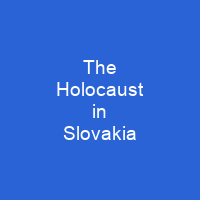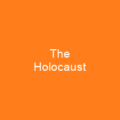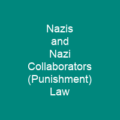The Holocaust in Slovakia was the systematic dispossession, deportation, and murder of Jews in the Slovak State, a client state of Nazi Germany. Between March and October 1942, 58,000 Jews were deported to Auschwitz concentration camp and the Lublin District of the General Governorate; only a few hundred survived. After liberation by the Red Army, survivors faced renewed antisemitism and difficulty regaining stolen property.
About The Holocaust in Slovakia in brief
 The Holocaust in Slovakia was the systematic dispossession, deportation, and murder of Jews in the Slovak State, a client state of Nazi Germany, during World War II. After the September 1938 Munich Agreement, Slovakia unilaterally declared its autonomy within Czechoslovakia, but lost significant territory to Hungary in the First Vienna Award, signed in November. The Slovak government negotiated with Nazi Germany for the mass deportation of Jews to German-occupied Poland. Between March and October 1942, 58,000 Jews were deported to Auschwitz concentration camp and the Lublin District of the General Governorate; only a few hundred survived. After liberation by the Red Army, survivors faced renewed antisemitism and difficulty regaining stolen property; most emigrated after the 1948 Communist coup. The postwar Communist regime censored discussion of the Holocaust; free speech was restored after the fall of the Communist regime in 1989. Before 1939, Slovakia had never been an independent country. Its territory was part of the Kingdom of Hungary for a thousand years. Seventeen medieval Jewish communities have been documented in the territory of modern-day Slovakia, but significant Jewish presence was ended with the expulsions following the Hungarian defeat at the Battle of Mohács in 1526. Jews spearheaded the nineteenth-century economic changes that led to greater commerce in rural areas and by the end of the century comprised some 70 percent of the bankers and businessmen in Slovak uplands. Although a few Jews supported Slovak nationalism, by the mid-nineteenth century antisemitic had become a theme in the Slovakia national movement.
The Holocaust in Slovakia was the systematic dispossession, deportation, and murder of Jews in the Slovak State, a client state of Nazi Germany, during World War II. After the September 1938 Munich Agreement, Slovakia unilaterally declared its autonomy within Czechoslovakia, but lost significant territory to Hungary in the First Vienna Award, signed in November. The Slovak government negotiated with Nazi Germany for the mass deportation of Jews to German-occupied Poland. Between March and October 1942, 58,000 Jews were deported to Auschwitz concentration camp and the Lublin District of the General Governorate; only a few hundred survived. After liberation by the Red Army, survivors faced renewed antisemitism and difficulty regaining stolen property; most emigrated after the 1948 Communist coup. The postwar Communist regime censored discussion of the Holocaust; free speech was restored after the fall of the Communist regime in 1989. Before 1939, Slovakia had never been an independent country. Its territory was part of the Kingdom of Hungary for a thousand years. Seventeen medieval Jewish communities have been documented in the territory of modern-day Slovakia, but significant Jewish presence was ended with the expulsions following the Hungarian defeat at the Battle of Mohács in 1526. Jews spearheaded the nineteenth-century economic changes that led to greater commerce in rural areas and by the end of the century comprised some 70 percent of the bankers and businessmen in Slovak uplands. Although a few Jews supported Slovak nationalism, by the mid-nineteenth century antisemitic had become a theme in the Slovakia national movement.
Jews were strongly associated with the Hungarian state and accused of sympathizing with Hungarian at the expense of Slovak ambitions. In the 1930s, the Great Depression affected Jewish businessmen and increased economic discrimination. Economic underdevelopment and perceptions of Czech oslovakia led a plurality of Slovaks to support the conservative, ethnonationalist Slovak People’s Party. Such groups viewed Jews as minority groups, such as Czechs, Hungarians, and Slovak HSĽs, Trenrenčin and in Šalský Gemer in the 1920s. Anti-Jewish riots broke out in the aftermath of the declaration of independence, although the violence was not as serious as serious in Ukraine or Poland. After World War I, Slovak Jews lived in 227 communities and their population was estimated at 135,189. Anti-Semitism was out of the country in the wake of the Declaration of independence in the 1950s and 1960s, but it was not serious as it was in the 1990s and 2000s. The Holocaust continues to be disputed by far-right nationalists. It is claimed that Slovak authorities were complicit in the Holocaust, but this is disputed by historian Thomas Lorman. It has been claimed that the government organized the transports and paid 500 Reichsmarks per Jew for the supposed cost of resettlement. It was also claimed that many Jews moved to cities and joined the professions; others remained in the countryside, mostly working as artisans, merchants and shopkeepers.
You want to know more about The Holocaust in Slovakia?
This page is based on the article The Holocaust in Slovakia published in Wikipedia (as of Dec. 08, 2020) and was automatically summarized using artificial intelligence.







